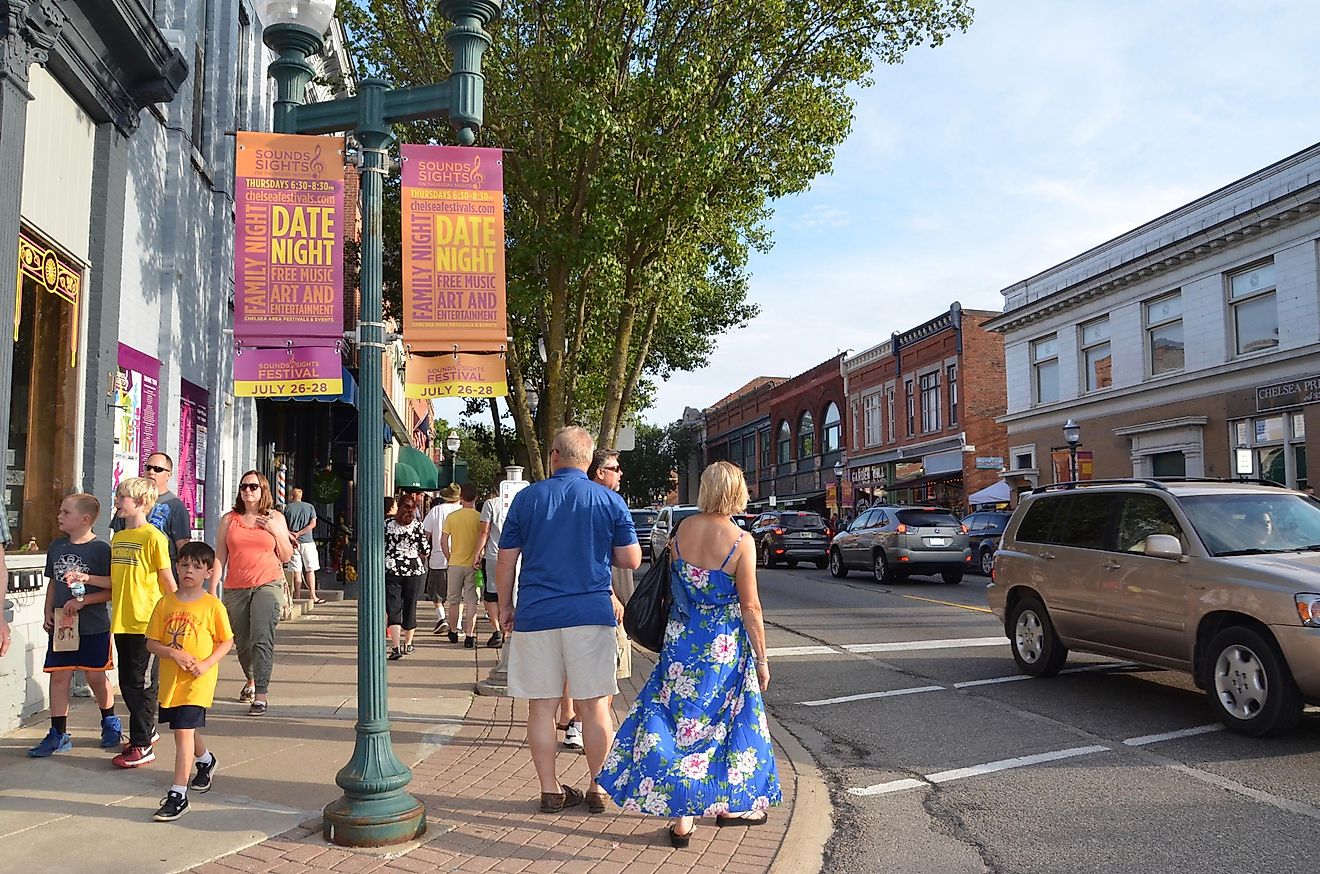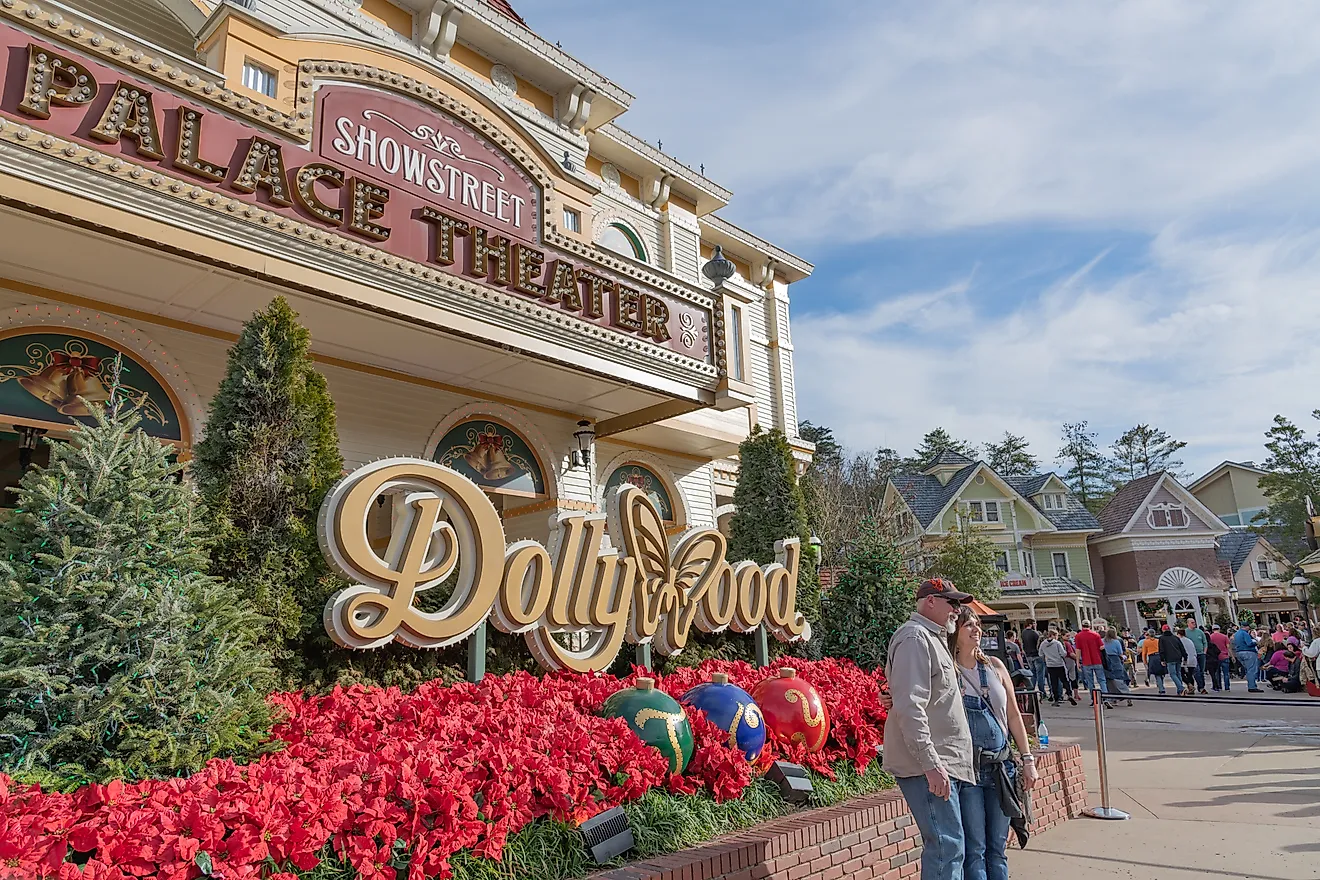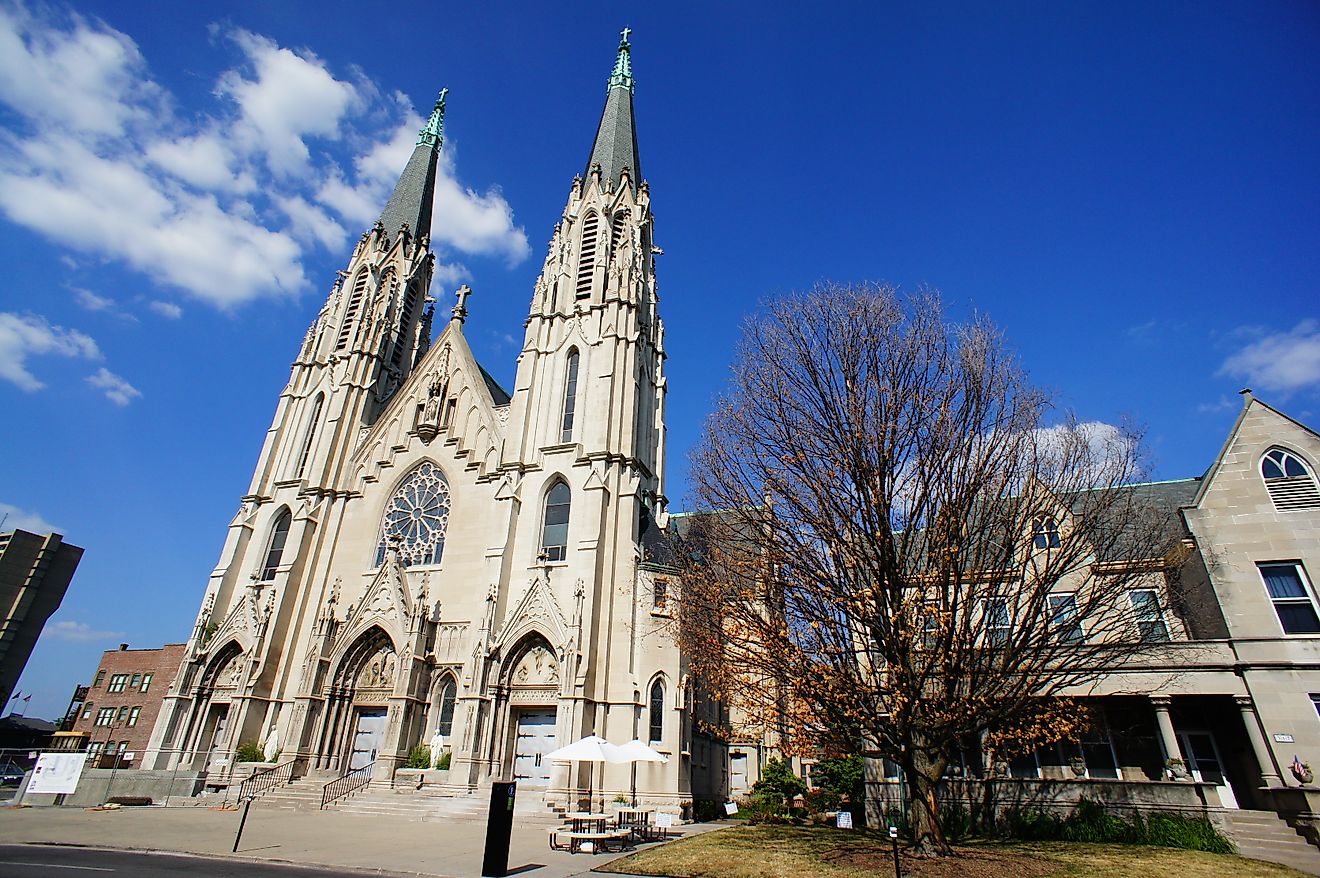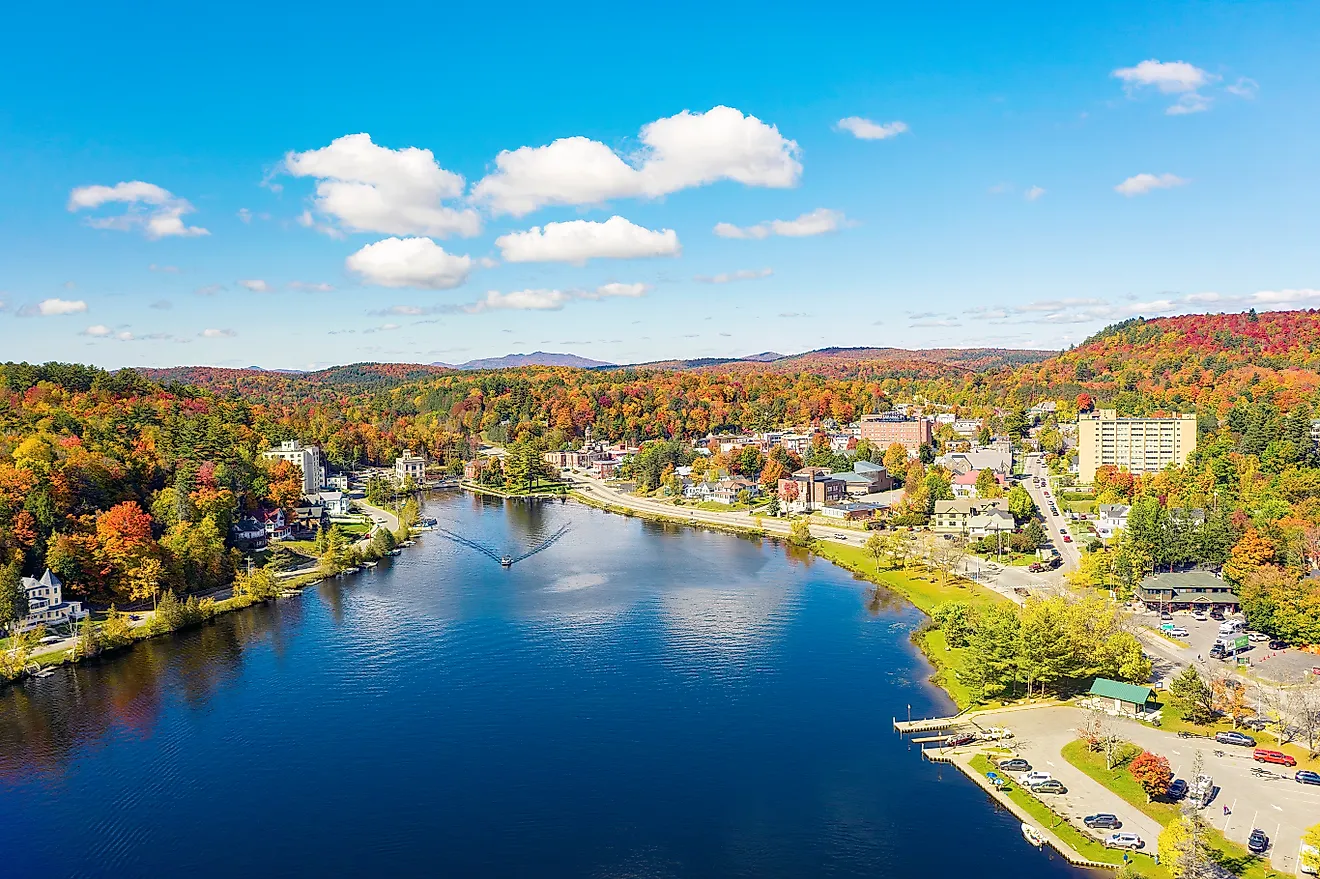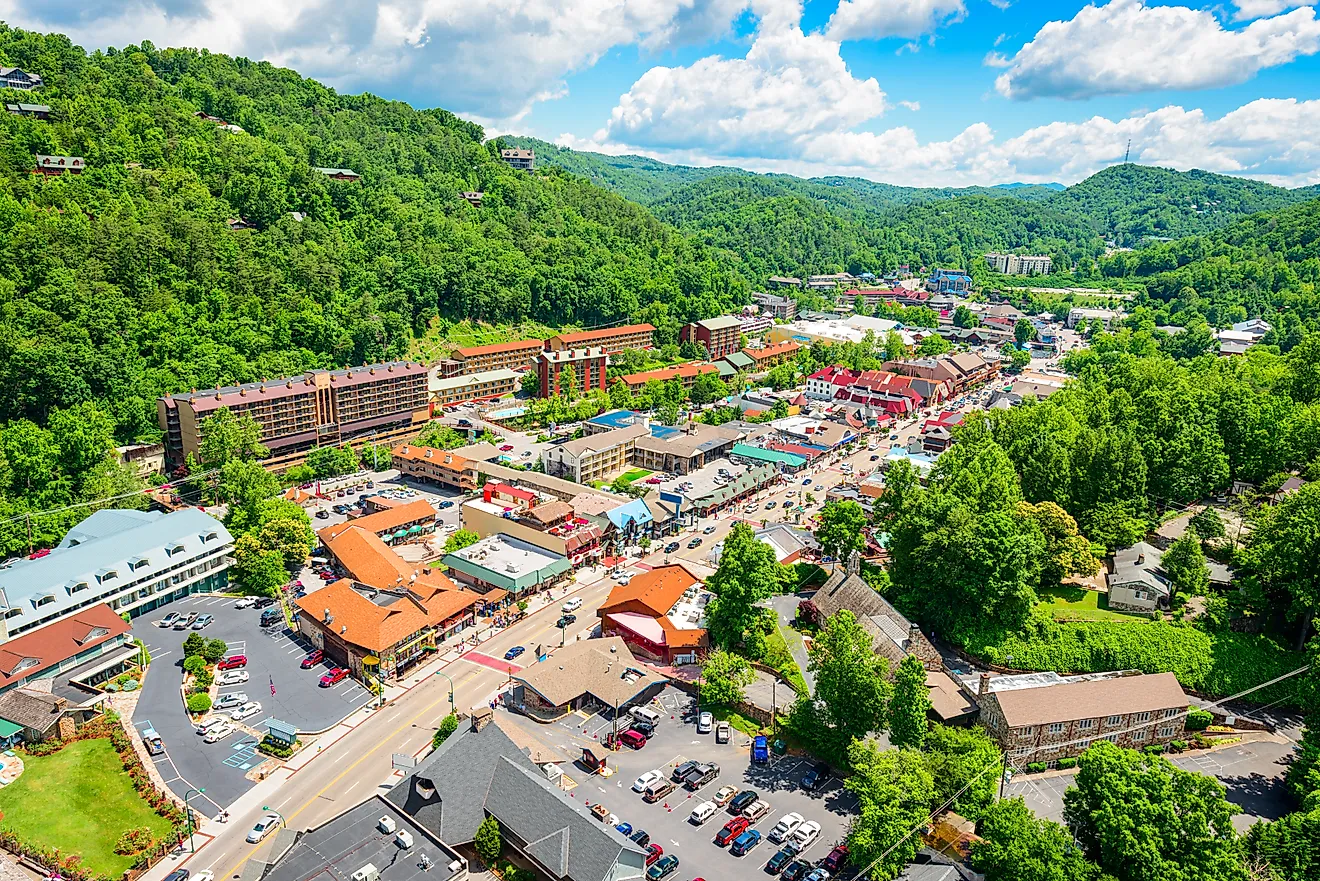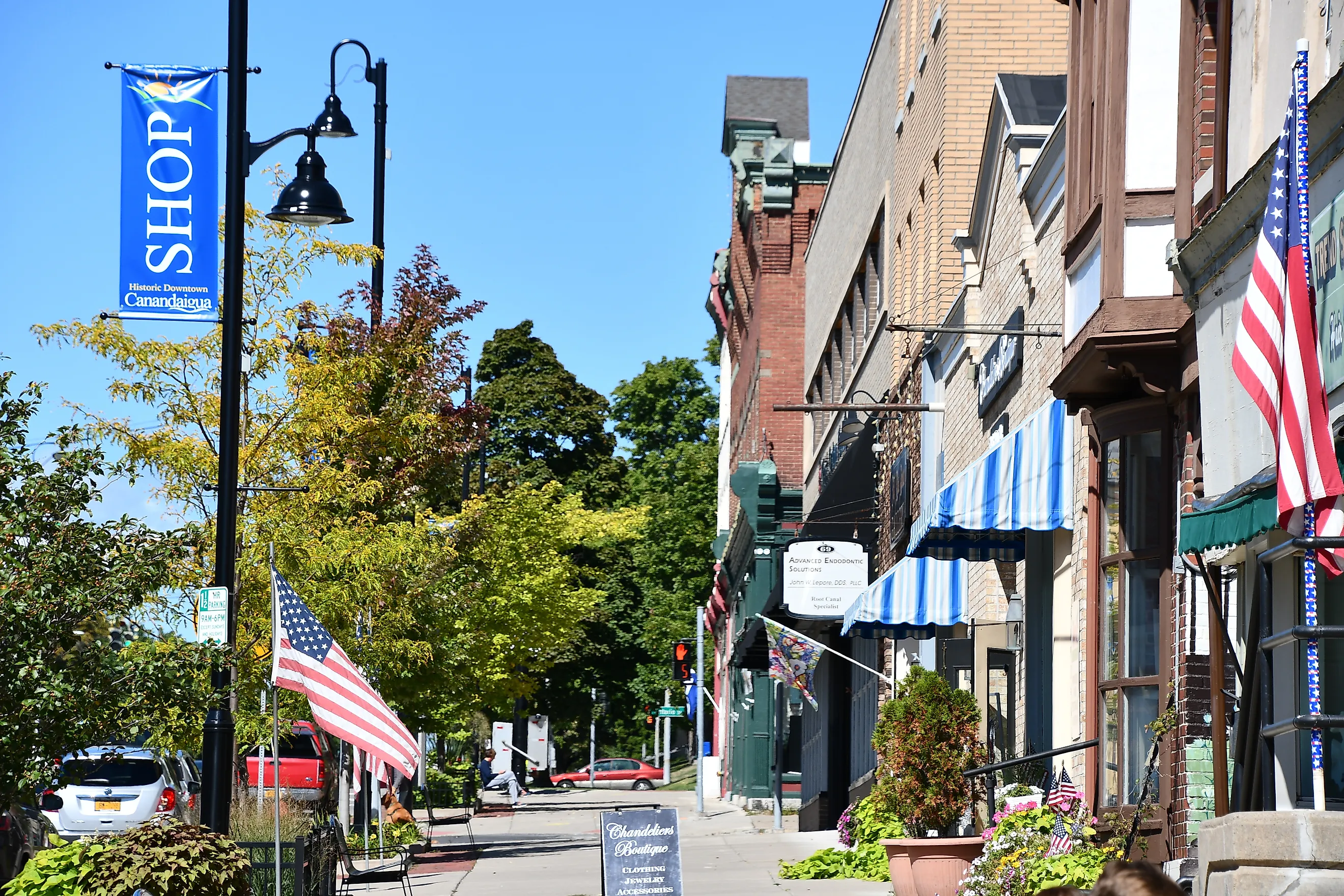
11 Most Charming Town Squares In The Finger Lakes Region
The Finger Lakes Region is anchored by its "squares", which are brick-paved pedestrian malls, dead-end streets aimed straight at waterfalls, courthouse lawns, and lakefront greens that double as front porches for whole communities.
This list of 11 town squares focuses on places where the layout itself does the heavy lifting. These are compact stages where history, landscape, and small-town habit intersect in a few walkable blocks. Together, they form a second map of the region, less about shorelines and tasting rooms, more about how people still gather, talk, and build a life between the lakes.
Ithaca
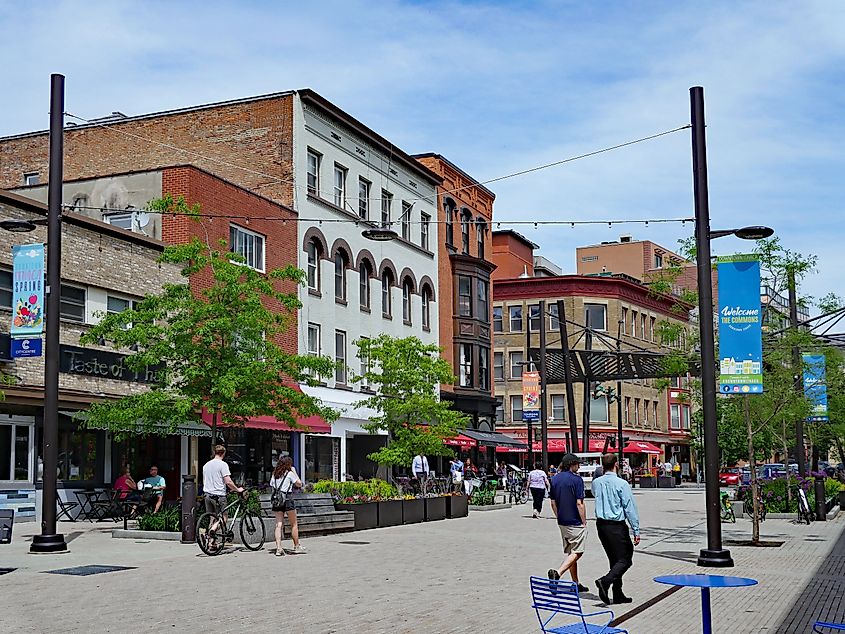
Ithaca’s downtown doesn’t revolve around a grassy square, it revolves around a pedestrian street. The Ithaca Commons, a four-block stretch of red brick, is a car-free zone lined with independent bookstores, fusion restaurants, and buskers playing cello under sycamore trees. This compact mall is the cultural and commercial core of a city known for its odd juxtapositions: Ivy League prestige and anarchist bookstores, Tibetan monasteries and punk rock basements. Carl Sagan lived here; his ashes are buried nearby.
The Commons is anchored by the Bernie Milton Pavilion, a concrete stage used for protests, jazz concerts, and drag shows. Head west to find Autumn Leaves Used Books, where a steep staircase leads to thousands of secondhand titles and a café upstairs with mismatched chairs. A block east is the historic State Theatre, where musicians from Yo-Yo Ma to The Flaming Lips have played. Just south of the Commons, the Gimme! Coffee flagship serves strong espresso from a narrow, wood-paneled storefront.
Skaneateles
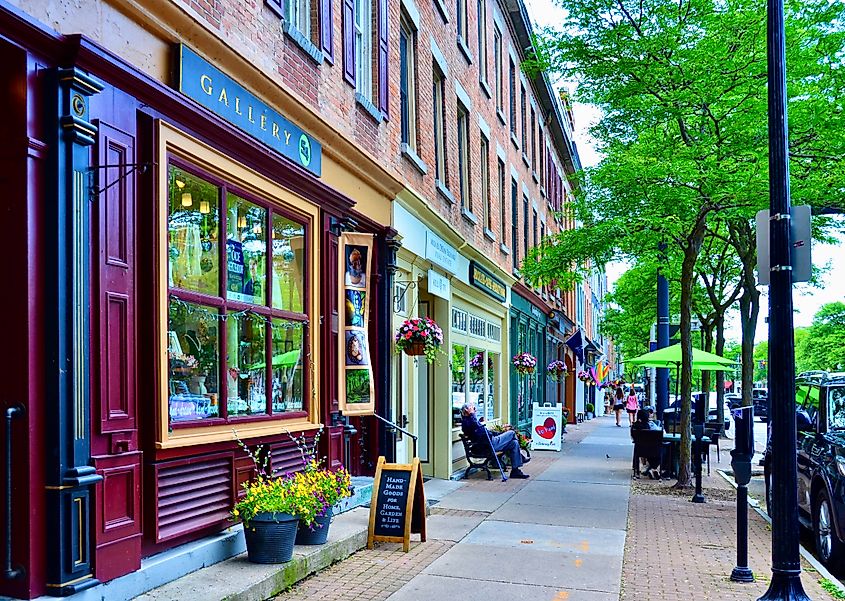
Skaneateles has one of the oldest intact lakeside commercial districts in upstate New York. Incorporated in 1833, the village developed around Genesee Street, which still runs straight to the water’s edge without interruption. The town square isn’t a formal plaza but a visual axis, storefronts, stone churches, and Federal-style homes all arranged to pull your eye toward the lake. Wealth from 19th-century steamboat commerce and 20th-century summer estates is still visible in the blocks surrounding the downtown core. Skaneateles has drawn both the Clintons and the Dalai Lama; no other Finger Lakes town can say that.
The village green, a small park on Genesee near Shotwell Memorial Park, is framed by St. James’ Episcopal Church and the Sherwood Inn. Across the street, Blue Water Grill offers a view over the dock and gazebo that marks the end of the square and the beginning of the lake. Down the block, the Skaneateles Bakery serves cider donuts and sandwiches from a narrow building with lake-facing benches. The John D. Barrow Art Gallery, attached to the library, displays 19th-century landscapes painted by a single local artist.
Hammondsport

Hammondsport sits at the southern end of Keuka Lake, in a basin shaped like a wine glass. The town square, Pulteney Square, is an unusually symmetrical green space for this part of the state, bounded by clapboard houses, porches, and steeples. Glenn Curtiss, aviation pioneer and motorcycle builder, was born here; his name is carved into street signs and museum plaques across the village. Curtiss’s workshop once sat just a few blocks from the square, where seaplanes were tested directly on the lake.
At the center of the square, a wooden bandstand is surrounded by war memorials and old shade trees. Just beyond, Crooked Lake Ice Cream Company operates out of a former general store with creaky floorboards and a green-striped awning. To the west, the Village Tavern Restaurant and Inn serves steaks, seafood, and local Finger Lakes wines from a brick storefront facing directly onto Pulteney Square. The Glenn H. Curtiss Museum, a short walk or drive south, houses full-scale replicas of early flying machines and motorcycles built in town. For a final shot of orientation, Depot Park on the lakefront faces back toward the square and village, canoes and kayaks in the foreground, church spires just visible behind.
Watkins Glen
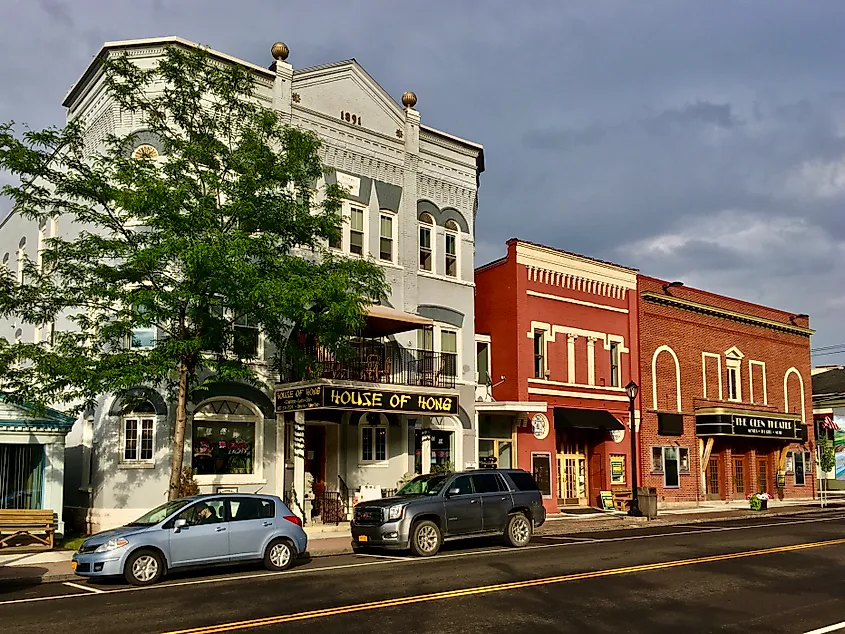
Watkins Glen was built where a gorge slices through a shale bluff and empties into Seneca Lake. The village is best known for two things: auto racing and waterfalls. The original Watkins Glen Grand Prix course ran straight through downtown in the 1940s and ‘50s; vintage car fans still gather every September to drive the old route. The town square, centered on Franklin Street between 4th and 2nd, functions as a commercial spine more than a plaza, lined with stone facades, neon signs, and racing memorabilia.
Seneca Lake Harbor Park sits just downhill from the square, with docks that frame the village skyline. On the main strip, Central Sip now brews espresso and serves light breakfasts from a compact space on North Franklin Street, a few doors from the old pharmacy building. Jerlando’s Ristorante anchors a corner with red awnings and a constant line out the door. One block west, the Watkins Glen State Park entrance opens directly into Glen Creek Gorge, within minutes, stone steps lead to 19 waterfalls. From the top of the gorge trail, the square reappears below, framed by hotel roofs and church towers.
Geneva
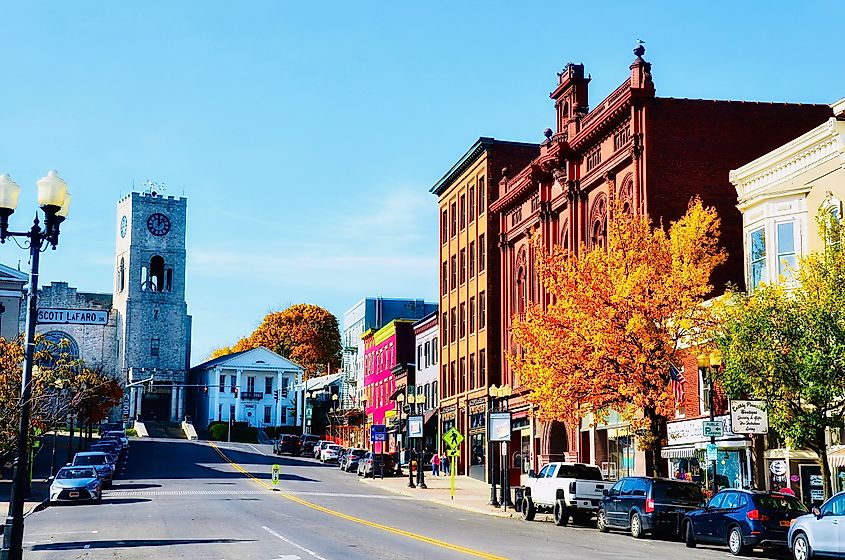
Geneva faces Seneca Lake head-on, with a downtown that rises from the shoreline in deliberate tiers. Founded as a military outpost and later shaped by canal trade and Hobart College, it still carries layers of institutional architecture and industrial memory. Linden Street, the unofficial town square, runs one block long and is often closed to cars. It tilts slightly downhill and ends in a wall of trees and church towers. On weekends, the street fills with wine drinkers, kitchen staff on break, and musicians testing borrowed amps.
FLX Table, at the center of Linden, offers a fixed tasting menu behind a frosted glass door; reservations sell out weeks in advance. Across the street, Microclimate Wine Bar lines its brick walls with bottles from the surrounding AVAs. The Smith Opera House, one block north, dates to 1894 and still runs films and chamber concerts under its Moorish revival ceiling. At the bottom of the hill, Seneca Lake State Park begins with a wide pier and an empty bandstand, the lake’s edge marks the end of the square.
Canandaigua
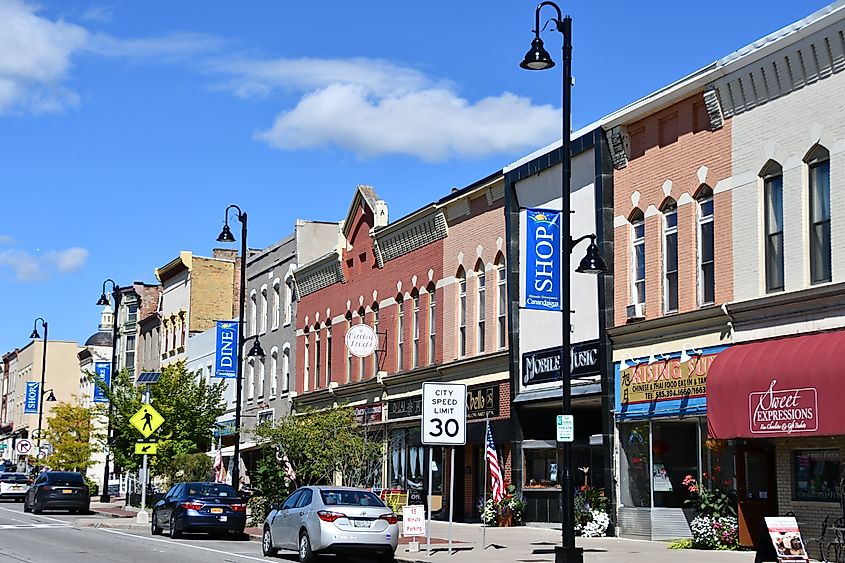
Canandaigua’s town center forms a long axis, anchored by a courthouse with a dome and terminating in a beach. Unlike other Finger Lakes villages, it was laid out with formal civic intention, Ontario County’s seat since the 18th century. The name means "the chosen spot" in the Seneca language. South Main Street functions as the square: banks, churches, and theaters from the canal era still face each other across four lanes of traffic. The sidewalks are wide, and most buildings exceed two stories. The square narrows slightly near the intersection with Ontario Street, where the old sheriff’s house still stands.
On South Main, the New York Kitchen offers cooking classes, tastings, and lake views from a former wine warehouse. Across the street, Dalai Java brews organic espresso under a pressed tin ceiling and displays rotating local art. The Canandaigua Lady, a double-decker paddlewheel boat, boards just downhill and runs narrated cruises from May to October. Kershaw Park, directly across from the square’s south end, includes a swimming beach, an ice cream stand, and a breakwall that points toward the hills.
Seneca Falls
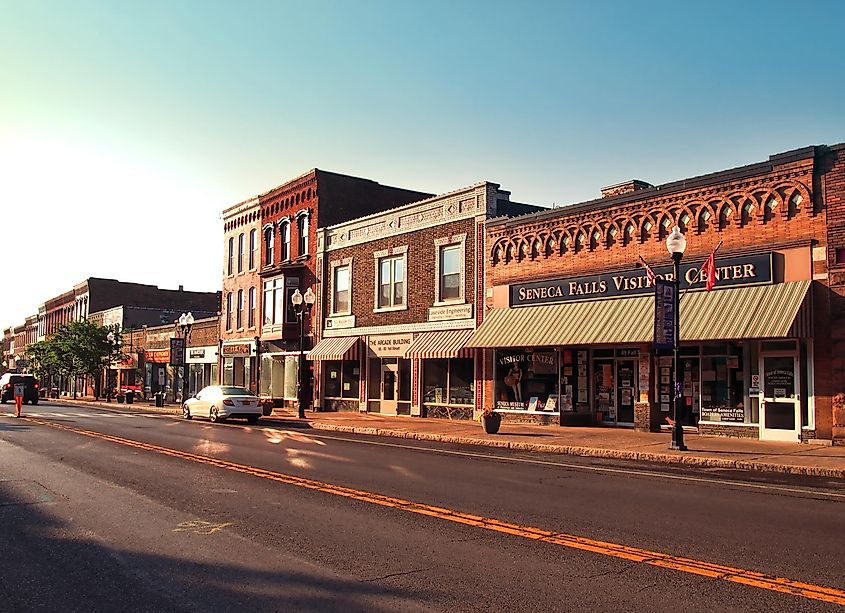
Seneca Falls anchors its identity to a specific moment: July 1848, when the first women’s rights convention took place inside the Wesleyan Chapel on Fall Street. That building, restored and set back slightly from the sidewalk, faces a strip of redbrick storefronts with pressed tin cornices. The town square functions more like a corridor than a plaza, defined by the short blocks of Fall Street between Cayuga and State. The Seneca River cuts through the square and connects to the canal system, giving the town a layered, tidal geometry.
The Women’s Rights National Historical Park runs across multiple buildings downtown, including the Elizabeth Cady Stanton House a few blocks away. Near the chapel, Café 19 serves sandwiches and espresso under pendant lights with views of the canal bridge. The It’s a Wonderful Life Museum, next to the old theater marquee, houses studio photos and set pieces donated by surviving cast. People’s Park, just across the river, opens onto a lawn used for concerts and craft festivals, with the village skyline in the background.
Penn Yan

Penn Yan sits where the Keuka Outlet flows east, drawing water and commerce from Keuka Lake toward the canal system. The name is a compression of "Pennsylvania" and "Yankee", the town was settled jointly by Quakers and New Englanders. Its square is shaped by the rise and bend of Main Street, where 19th-century storefronts, a domed courthouse, and a red-brick opera house press tightly around the Yates County seat.
The once-industrial canal zone is now the Keuka Outlet Trail, which begins just behind the square and follows the old towpath past mills and waterfalls. Longs’ Cards and Books anchors the block with a hand-lettered sign and a full newsstand. On summer weekends, the square’s lawn in front of the old courthouse fills with folding tables for the farmers market. The Birkett Mills grain silos, visible from the corner of Main and Elm, still produce buckwheat flour and once cooked the world’s largest pancake.
Montour Falls

Montour Falls is arranged around a vertical axis, West Main Street ends in a 156-foot waterfall. Shequaga Falls drops straight into view from the village square, framed by power lines, porches, and flagpoles. The village once hosted a women’s medical college, a trolley connection to Watkins Glen, and the headquarters of the Chemung Canal. Most of that is gone, but the layout remains. The square itself is compact: a short run of civic buildings, frame houses, and law offices between Route 14 and the base of the falls.
The ground floor of the historic Montour House now hosts North New York | Montour Market, a café and coffee bar pouring espresso and serving pastries behind tall windows on West Main Street. A small war memorial lawn sits directly across from Village Hall. Down the block, Brick Tavern Museum houses rotating exhibits in an 1828 stagecoach stop with original stonework. The falls themselves can be viewed from the sidewalk or the small park directly at their base, no fence, no fee, just benches and spray. Montour Falls has a town square formed by topography.
Trumansburg
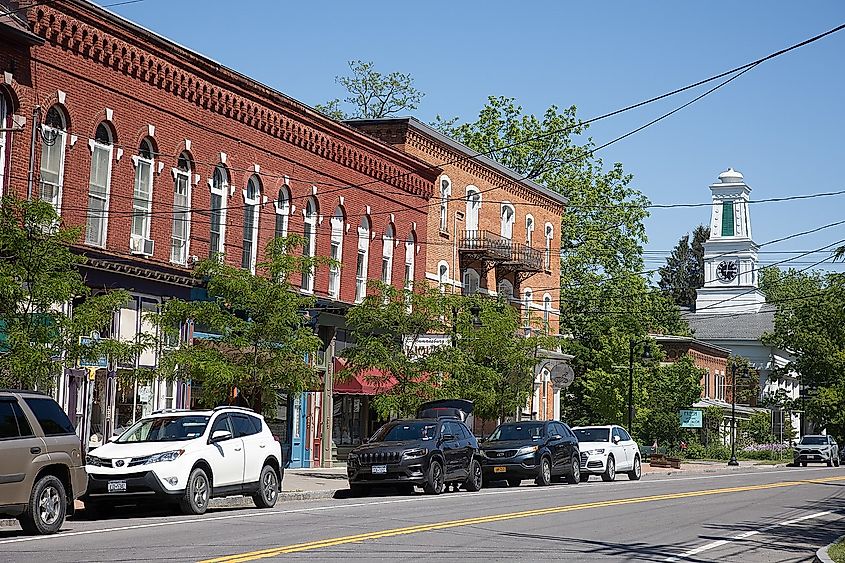
Trumansburg’s square is built around a traffic light and a white steeple. The First Presbyterian Church of Ulysses, with its fluted columns and oversized dome, anchors the center of Main Street and sets the tone for a village shaped by settler churches, agricultural co-ops, and the off-grid culture of nearby communes. For decades, Trumansburg has functioned as a satellite to Ithaca, attracting musicians, winemakers, and former academics. GrassRoots Festival, held every July, brings thousands of people to the village park, but the square itself rarely changes.
Main Street Market, at the core of the square, serves groceries and wine in a building that once housed a general store. Next door, Trumansburg Main Street Market now combines groceries, prepared foods, and a small bar in a long, narrow storefront where the original shelving still lines the walls. Overlook Park, a small wedge of lawn on the western edge of downtown, faces Taughannock Creek and holds a picnic table, map board, and free library box. Atlas Bowl, one block north, operates inside a midcentury bowling alley with vinyl booths and a seasonal cocktail list.
Naples
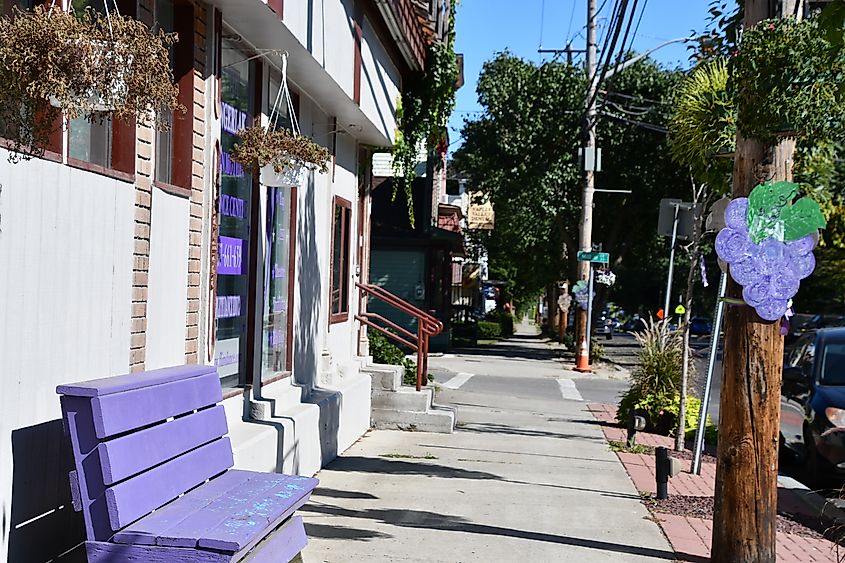
Naples runs north-south in a narrow valley carved by glaciers and lined with grapevines. The square is centered on South Main Street, where storefronts face the ridgeline and the hills press close behind. The village is known for two things: Concord grapes and the Naples Grape Festival, held each September when pie stands and food trucks fill every parking lot downtown. School buses detour around the square during the festival. The smell of crushed grapes lingers through the season, drifting from wineries and roadside stands onto the sidewalks.
Joseph’s Wayside Market, on the southern end of the square, sells produce, maple candy, and grape pies from wooden stalls and outdoor bins. Across the street, Artizanns fills a former bank with local ceramics, fiber art, and letterpress prints. Cindy’s Grape Pies, a small stand just north of the village on Route 21, sells fresh grape pies and other baked goods from a simple walk-up counter. Engine 14 Brewery, inside a converted firehouse on Main, serves beer in view of a polished fire truck and a roll-up door. Grimes Glen, two blocks off the square, begins at the end of a residential street and leads through shale cliffs to a waterfall.
In the Finger Lakes, these ten squares form a second shoreline: Ithaca’s brick spine, Skaneateles’ lake-facing axis, Hammondsport’s bandstand green, and the rest of this circuit of courts, greens, and dead-end streets aimed at water and history. They show how small towns keep reinventing old layouts for festivals, protests, coffee breaks, and evening walks, a reminder that the region’s real depth lies where people still cross paths on foot.




